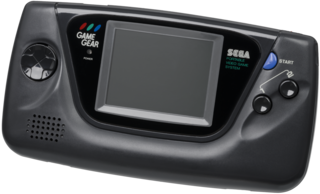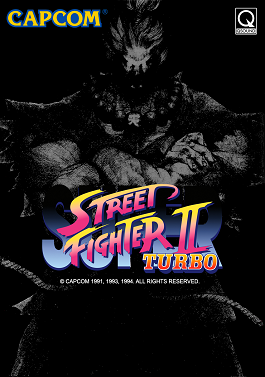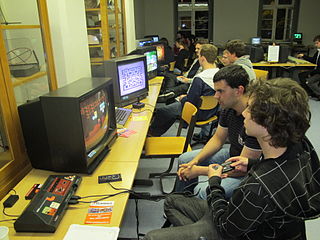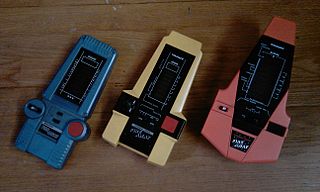
A handheld game console, or simply handheld console, is a small, portable self-contained video game console with a built-in screen, game controls and speakers. Handheld game consoles are smaller than home video game consoles and contain the console, screen, speakers, and controls in one unit, allowing people to carry them and play them at any time or place.

The Game Gear is an 8-bit fourth generation handheld game console released by Sega on October 6, 1990, in Japan, in April 1991 throughout North America and Europe, and during 1992 in Australia. The Game Gear primarily competed with Nintendo's Game Boy, the Atari Lynx, and NEC's TurboExpress. It shares much of its hardware with the Master System, and can play Master System games by the use of an adapter. Sega positioned the Game Gear, which had a full-color backlit screen with a landscape format, as a technologically superior handheld to the Game Boy.

A fighting game, also known as a versus fighting game, is a genre of video game that involves combat between two or more players. Fighting game combat often features mechanics such as blocking, grappling, counter-attacking, and chaining attacks together into "combos". Characters generally engage in battle using hand-to-hand combat—often some form of martial arts. The fighting game genre is related to, but distinct from, the beat 'em up genre, which pits large numbers of computer-controlled enemies against one or more player characters.

Street Fighter II: The World Warrior is a fighting game developed by Capcom and originally released for arcades in 1991. It is the second installment in the Street Fighter series and the sequel to 1987's Street Fighter. It is Capcom's fourteenth game to use the CP System arcade system board. Street Fighter II improved many of the concepts introduced in the first game, including the use of special command-based moves, a combo system, a six-button configuration, and a wider selection of playable characters, each with a unique fighting style.
In the history of video games, the fourth generation of game consoles, more commonly referred to as the 16-bit era, began on October 30, 1987, with the Japanese release of NEC Home Electronics' PC Engine. Though NEC released the first console of this era, sales were mostly dominated by the rivalry between Sega and Nintendo across most markets: the Sega Mega Drive and the Super Nintendo Entertainment System. Cartridge-based handheld consoles became prominent during this time, such as the Nintendo Game Boy (1989), Atari Lynx (1989), Sega Game Gear (1990) and TurboExpress (1990).

Super Street Fighter II Turbo is a fighting game released for the arcades by Capcom in Japan on February 23, 1994, in North America on February 23 and March 26, 1994 (beta) and in Europe in March 1994 (beta). It is the fifth installment in the Street Fighter II sub-series of Street Fighter games, following Super Street Fighter II: The New Challengers. Like its predecessor, it ran on the CP System II hardware.

The TV Boy and its successors TV Boy II and Super TV Boy are 1990s handheld TV games sold by many different companies, including Systema, Akor, and NICS, based upon an unlicensed clone of Atari 2600 hardware. They were widely available across Europe. In the UK, they were most visibly available through Argos. They were released around 1992 and three years later, an improved version of the TV Boy 2, the Super TV Boy, was also made by Akor.
1994 saw many sequels and prequels in video games, such as Super Metroid, Donkey Kong Country, Final Fantasy VI, Sonic 3 & Knuckles, Super Street Fighter II Turbo and Virtua Fighter 2 and Doom II, along with new titles such as Daytona USA, Ace Driver, Alpine Racer and Tekken.

Handheld electronic games are very small, portable devices for playing interactive electronic games, often miniaturized versions of video games. The controls, display and speakers are all part of a single unit. Rather than a general-purpose screen made up of a grid of small pixels, they usually have custom displays designed to play one game. This simplicity means they can be made as small as a smartwatch, and sometimes are. The visual output of these games can range from a few small light bulbs or LED lights to calculator-like alphanumerical screens; later these were mostly displaced by liquid crystal and vacuum fluorescent display screens with detailed images and in the case of VFD games, color. Handhelds' popularity was at its peak from the late 1970s into the early 1990s before declining. They are the precursors to the handheld game console.

ABA Games is a Japanese video game developer, composed solely of game designer Kenta Cho. ABA Games' works, available as open source, are predominantly shoot 'em up games often inspired by classic games in the genre. Its games feature stylised retro graphics, innovative gameplay features and modes and feature random rather than scripted events. These creations have been acclaimed as some of the best independent games available, though some commentators, including Cho himself, feel they are too simple for commercial release.

Retrogaming, also known as classic gaming and old school gaming, is the current playing and collection of obsolete personal computers, consoles, and video games. Usually, retrogaming is based upon systems that are outmoded or discontinued, although ported retrogaming allows games to be played on modern hardware via ports or compilations. It is typically for nostalgia, preservation, or authenticity. A new game could be retro styled, such as an RPG with turn-based combat and pixel art in isometric camera perspective.
VG Pocket is a series of handheld dedicated game consoles built by JungleTac and sold by Performance Designed Products LLC. The VG Pocket model was the first console of its type to have a 2" backlit color LCD screen.

The Game Boy is an 8-bit fourth generation handheld game console developed and manufactured by Nintendo. It was first released in Japan on April 21, 1989, in North America later the same year, and in Europe in late 1990. It was designed by the same team that developed the Game & Watch series of handheld electronic games and several Nintendo Entertainment System (NES) games: Satoru Okada, Gunpei Yokoi, and Nintendo Research & Development 1.

Neo Geo is a family of video game hardware developed by SNK. On the market from 1990 to 2004, the brand originated with the release of an arcade system, the Neo Geo Multi Video System (MVS) and its home console counterpart, the Neo Geo Advanced Entertainment System (AES).

The R-Zone is a portable game console developed and manufactured by Tiger Electronics. The R-Zone was shown at the American International Toy Fair in February 1995, and was released later that year. The R-Zone was panned by critics, and was also a commercial disaster, with its lifespan lasting only 2 years before being discontinued in 1997. Although the R-Zone was not designed to compete directly with any other handhelds, it marked Tiger Electronics' first multi-game entry into the portable electronic game market.

Fire Away was a series of handheld electronic games marketed by Tandy beginning in the 1980s. In all, there were six different products in the line, nearly all of which were actually licensed by Tandy rather than being original Tandy games. The games looked to capitalize on the popularity of the video game Space Invaders which was released in 1978.
The Evercade is a handheld game console developed and manufactured by UK company Blaze Entertainment. It focuses on retrogaming with ROM cartridges that each contain a number of emulated games. Development began in 2018, and the console was released in May 2020, after a few delays. Upon its launch, the console offered 10 game cartridges with a combined total of 122 games.












